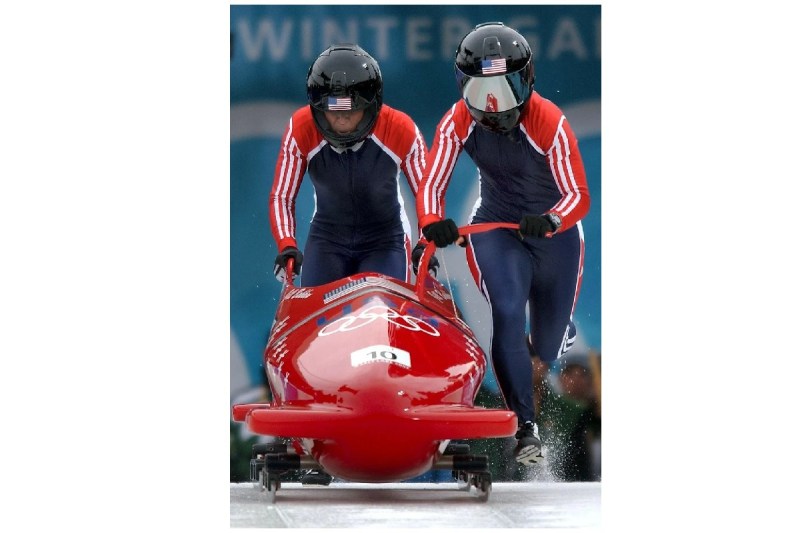If you grew up in the ‘90’s, your first exposure to the bobsled may have been through the Disney movie Cool Runnings, which was loosely based on the 1986 Winter Olympics champion Jamaican bobsled team. For years after the movie debuted, kids around the country jumped onto their winter sleds ala a bobsled approach to emulate the charismatic bobsled athletes in the lighthearted, inspiring movie.
- What Is Bobsledding?
- When Did Bobsled Become an Olympic Sport?
- What Is the Bobsled Sled Like?
- How Many Athletes Compete in Bobsled at the Winter Olympics?
- What Are the Bobsledding Events at the Winter Olympics?
- What Is the Competition Format for Bobsled Events at the Winter Olympics?
- Bobsled at the 2022 Winter Olympic Games in Beijing
Bobsled is a fast, thrilling sport with several events at the Winter Olympics. It is somewhat related to the Winter Olympic events of luge and skeleton because they are all sliding sports, but bobsledding is unique in many ways as well. Keep reading to learn the basics of bobsledding and all about bobsledding at the Winter Olympics.
What Is Bobsledding?

Bobsled is a sliding sport that involves racing a sled down a downhill track covered in ice by steering through twists, turns, and straightaways. The track has steep walls. Bobsled is actually a discipline of the larger sport, bobsleigh, which also includes the skeleton racing events. Some bobsled events involve a team of 2-4 athletes while there is also a solo bobsled event (monobob). Bobsled speeds may exceed 150 km/hr.
When Did Bobsled Become an Olympic Sport?

Bobsled was actually one of the sports contested at the inaugural Winter Olympic Game in 1924. Only the four-man bobsledding event was included, and it was won by Swiss athlete, Eduard Scherrer. The two-man bobsledding event was added for the 1932 Lake Placid Games, but women’s bobsledding events did not debut until the 2002 Winter Olympic Games.
Historically, Switzerland, the United States, and Germany have had the strongest showing of bobsled athletes in the Olympic Games.
What Is the Bobsled Sled Like?
The sled used for bobsled consists of a main hull (also called a cowling), a frame, two sets of runners, and a front and rear axle. The back is open and the hull is usually constructed from fiberglass. The bobsled driver steers the sled by pulling on two pieces of rope, which are attached to a steering bolt on the front frame of the sled. To steer the sled to the right, the bobsled driver pulls on the right rope, and to steer the sled to the left, the driver pulls on the left rope.
There are minimum and maximum weight limits for the sleds plus the bobsled athletes. Teams that come in under the weight limit can add a ballast.
How Many Athletes Compete in Bobsled at the Winter Olympics?
At the 2022 Winter Olympics in Beijing, there will be a maximum of 170 bobsled athletes for the four bobsledding events. Of these 170 quota spots, 124 are for men and 46 are for women. Olympic bobsledding athletes qualify based on the world rankings.
What Are the Bobsledding Events at the Winter Olympics?
There are four bobsledding events at the Winter Olympics: Two-Man, Four-Man, Two-Women, and Women’s Mobobob.
- Two-Man and Two-Woman Bobsled: The two-man and two-woman bobsled events consist of teams comprised of pairs of athletes. One athlete is the pilot and the other is the brakeman.
- Four-Man Bobsled: The four-man bobsled event has teams of a pilot, brakeman, and two crewmen/pushers.
- Women’s Monobob: The monobob is a solo bobsled where just the pilot competes in the sled.
What Is the Competition Format for Bobsled Events at the Winter Olympics?

All four bobsled events consist of four timed runs, with each event splitting these four runs over two days. Races are timed electronically to the 1/100th of a second. The finishing order is determined by computing the sum of each team’s four runs and ranking total time from fastest to slowest. Ties can occur.
The starting order for the first run is determined by the International Bobsleigh & Skeleton Federation ranking of the pilots. The starting order for the second heat is the inverse order of the finish times for the first heat, such that the slowest athlete goes first. For the third heat, the current rankings after the first two heats are followed, with the current leader racing first. However, only the top 20 teams or athletes in monobob move on to the fourth heat. The starting order for the final heat is the reverse order of the final 20 athletes (slowest to fastest).
To start the race, competitors receive an audio and visual signal. They then have 60 seconds to start their run. The sled usually starts about 50 feet behind the starting line, so athletes grab onto the sled in the starting block and begin running and pushing it toward the starting line. Once the starting line is crossed, electronic timing begins. Teams can technically push the sled as long as they want, but most go about 50 meters before fully jumping in.
To finish the race, all athletes must cross the line with the sled. If the sled crashes, they can keep going if all athletes still cross together with the sled. The sled does not have to be face up at the finish to be legal. However, if a team crashes on a run and fails to finish as a team, they are disqualified and cannot compete in any other runs.
Bobsled at the 2022 Winter Olympic Games in Beijing
At the 2022 Winter Olympics in Beijing, the four bobsled events will be contested at the Yanqing National Sliding Centre, which is in the Xiaohaituo mountain area about 74 kilometers northwest of Beijing. The track is 1,615 meters (approximately one mile). The bobsled track has a maximum gradient of 18% and 16 curves, including one 360-degree turn. Bobsled events will run from February 13-20.



